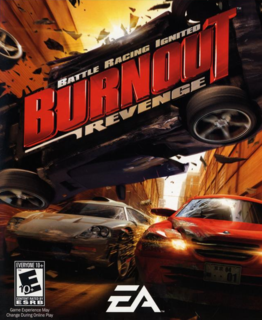Burnout Revenge gets your blood pumping for hours upon hours of explosive racing.
First of all, the gameplay modification that changes the entire experience of playing Burnout: Traffic Check, an opportunity to wreck same-way traffic at will - as long as you don't try to hit any trucks or buses. That's right, hitting same-way traffic won't cause a crash anymore - in fact, it will give you more boost! While it might seem that this diminishes the tension of driving around, it's actually another way of taking down other racers, since checked traffic will cause them to crash. Sure, racing becomes somewhat easier with this modification, but it gives more freedom to the player, allowing better strategies, which eventually makes the game less frustrating than Burnout 3. Basically, you can earn boost by staying on the oncoming traffic lane, or you can earn boost by checking traffic on the same-way lane, resulting in a much-needed balance for the series.
Another satisfying addition is the Crashbreaker during races. While it was a Crash Mode-only feature in previous games, Burnout Revenge offers the ability to blow up your car after a crash, taking an immediate revenge on the racer that took you out. Given this game's strong emphasis on revenge, it's extremely fun and rewarding to be thrown against the back of a bus, since you can blow up your car and immediately take down the opponent that attacked you in the first place. In real life, this "do justice with your own hands" attitude can be erroneous and dangerous - and that makes Burnout Revenge even more entertaining. Fortunately, the Crashbreaker can't be overused: if your explosion does not hit any other racers, you'll be left with zero boost, and events with this feature aren't available right away. Of course, there's nothing quite like being taken out and using the Crashbreaker to take out ALL your opponents, just in case they were right next to you, causing a "Total Payback". All this brutally satisfying destruction is probably at its best on the Road Rage events, where the objective is to complete as many take downs as possible. Fortunately, the other racers are always close to the player, so there's never a shortage of cars to take down, allowing for a constant rampage. The Traffic Attack is fairly similar, but instead of other racers you'll be hitting as much same-way traffic as possible. Crash Mode, a series veteran, had many changes, including a golf game-like system to "launch" your vehicle. Needless to say, there's plenty of fresh air in this game.
But the thrill of this game doesn't come entirely from explosions: if it weren't for Burnout's trademark sense of speed, the game wouldn't be so fun. Burnout Revenge definitely nails down the adrenaline-filled experience of speeding up to 209 miles per hour, whether you're dodging rush hour traffic or trees, jumping from bridges or dirt ramps, throwing your opponents off a cliff or at a bus - the speed is there, and there's nothing quite like it in other racing games.
The AI of the other racers always behaves in a way that no event can be decided at its beginning: if you're winning, you're always on your toes; if you're far behind, there's still a chance of winning. Thankfully, this raises the tension, and the frustration level is significantly lowered in comparison to Burnout 3. Overall, Burnout Revenge has a very balanced difficulty level, which gets even better thanks to the nearly-flawless track design, full of hidden paths, made to be much more entertaining than punishing for the player.
After all the compliments the gameplay deserves, it's hard to talk about how excellent the graphics are. While the game doesn't look as realistic as Gran Turismo 4, its dark Art style does a fantastic job at recreating Hollywood-like car chases and explosions, not to mention again the amazing sense of speed. Of course, that's not to say it doesn't look realistic: although some aspects (like Traffic Check) go against the laws of Physics, the majority of the game's graphics recreates our world very, very well.
Unfortunately, the audio is the portion that shines the least in Burnout Revenge, thanks to the soundtrack. All the sound effects coming from cars are excellent, but the soundtrack can make for an unpleasant experience. If you don't like pseudo-punk, exaggeratedly commercial music, you'll end up turning off 75% of the soundtrack, listening to about 10 of the game's 41 songs. This is something that changes from player to player, but the soundtrack is mostly unsatisfying.
All these elements wouldn't deliver well if the game was short - and Burnout Revenge delivers wonderfully in that aspect. The single-player mode can last well over 30 hours, not counting all the fun to be had in the Multiplayer modes, whether it's online or offline. Once you're done with the game, it'll leave the feeling of a satisfying experience. Burnout Revenge is possibly the most adrenaline-filled racing game out there, and its entertaining action can appeal to pretty much anyone.

